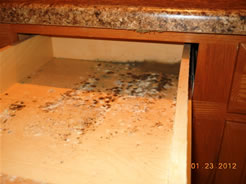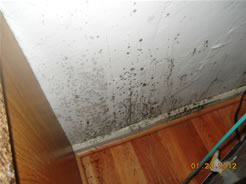There are many different types of mold and most people try to determine mold type by its color. Examples of mold colors include green, white, grey, brown, and black. The fact is that mold color hardly ever conveys ultra-specific information, as there exists both hazardous and non-hazardous types of mold within each group of colors. It is challenging, if not entirely impossible to establish whether or not a mold is dangerous based solely on its surface appearance.
 Molds found in kitchen drawer during inspectionDirect exposure to every type of mold is potentially unsafe for humans and animals. Molds generate allergens and irritants, which can be problematic. In some cases, mold will product toxins which can induce negative allergic reactions. The varieties and intensity of health issues depend at least in part on:
Molds found in kitchen drawer during inspectionDirect exposure to every type of mold is potentially unsafe for humans and animals. Molds generate allergens and irritants, which can be problematic. In some cases, mold will product toxins which can induce negative allergic reactions. The varieties and intensity of health issues depend at least in part on:- Type of mold is present
- Degree of direct exposure
- Age of exposed persons
- Level of sensitivity to allergies
There exists a direct connection between mold exposure within the home and disease. Even so, under ordinary conditions, most types and amounts of mold are not going to be dangerous for otherwise healthy people. The trouble comes up whenever molds are allowed to reach harmful levels. This, combined with long-term exposure can be quite problematic.
The black and gray mold color class is quite substantial and includes the following types:
- Cladosporium
- Pithomyces
- Stemphydium
- Ulocladium
- Aureobasidium
- Alternaria
- Stachybotrys
Stachybotrys is widely known as being dangerous due to its ability to generate mycotoxins, which create a prospective exposure threat whenever affected materials are moved about or disrupted. Stachybotrys mold generally only grows on wet materials which are comprised of cellulose. These materials are things such as cardboard, ceiling tiles, cellulose-based insulation, and other types of organic materials.
Some locations make use of a hazard class ranking system which helps define the hazard levels of the various types. These include:
- Class A: These molds are either directly detrimental to health because of the risk of illness and/or presence of toxins. These types warrant removal.
- Class B: These molds can trigger allergic reactions, particularly when exposure is lengthy.
- Class C: These molds are not associated with health risks, but they can cause damage to structures if not removed.
The following are common types of household molds:
 Cladosporium on kitchen wall behind refrigeratorCladosporium: A common mold. This type can appear to be green, gray, brown, or even black. Allergic reactions tend to be the only real health concern with this type. Growth can occur in a number of different places, such as walls, insulation, on wood, and more.
Cladosporium on kitchen wall behind refrigeratorCladosporium: A common mold. This type can appear to be green, gray, brown, or even black. Allergic reactions tend to be the only real health concern with this type. Growth can occur in a number of different places, such as walls, insulation, on wood, and more.Aspergillus: Another common type which can be one of many different colors such as gray brown, black, white, green, or even yellow. This type may lead to infections in persons who have weakened immune systems. Some of these types can produce toxins under specific circumstances. Aspergillus has the power to grow virtually anywhere, but will most likely appear on walls, insulating material, paper-based items, and soil.
Penicillium: Sound familiar? That's likely due to the fact that modern antibiotics are attributed to a varieties of Penicillium. Even so, this type can be hazardous. The most common colors are blue, green, and white. Expect to find this mold on food, walls, insulation, and more.
Ulocladium: typically either black or gray. This type usually grows in damp areas. It may trigger allergic reactions, but is generally not harmful. Expect to find this type of mold can on walls, near windows, and in basements or attics.
Acremonium: This mold is frequently discovered on insulation and drywall, but it can show up in just about any damp place. The most common colors are white, gray, and brown. There are various species of this type and some can be toxic.
Stachybotrys: This is the notorious black mold which is associated with a variety of health problems. This form requires a very wet area in which to form and grow. The color is black and this type is toxic and does require removal.
Alternaria: This mold appears to be very similar to Ulocladium. Black and gray are the most common colors. This type can trigger allergic reactions, and it is usually found on walls, near windows, in areas which are dusty, or just about anywhere where dampness is sufficient for growth.
Getting answers in regard to the mold in or around your home or business is simply a matter of hiring a trained professional to perform a mold inspection. Mold samples can be taken and tested in order to determine the exact types which are present. Since some types of molds can indeed be toxic, inspection and sampling are wise whenever mold is detected.


